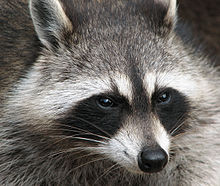Vibrissae


Vibrissae , also called sinus , feeler , tactile or whiskers ( Latin vibrissa , plural vibrissae ), are special hairs that most mammals grow on the face. They are thicker, stronger and longer than normal hair and specialize in the perception of tactile stimuli.
Like all hair, vibrissae are made of lifeless material, contain no nerves and also grow back. In contrast to other hairs, however, they are embedded in a special hair follicle, which contains a blood-filled capsule between its outer and inner layer, the so-called blood sinus . There are numerous free nerve endings in the wall. When a whisker is touched, it bends and moves the blood in the capsule to the side. The blood increases the movement and enables the nerves at the base to perceive even minimal stimuli. In some mammals, the follicles of the whisker hair are also surrounded by muscle tissue , which allows them to be moved to actively explore their surroundings.
Vibrissas offer animals advantages to find their way in the dark or in cloudy water, to perceive dangers or to track down food. Some animals, such as mice , can even feel the finest air or water movements with their whiskers. A large part of the brain of many mammals is busy evaluating the nerve impulses from the follicles of the whisker hair. The whiskers are vital for the animals.
Due to the spatial arrangement of the individual vibrissae and the ability to easily find this arrangement at every level of neuronal information processing, in the brain stem , in the thalamus and in the cerebral cortex , the vibrissae system of rats has become one of the most important model systems for tactile stimulus processing. Austria prohibits the removal of vibrissae from dogs. According to the report, other animals such as horses are also affected.
Related
The barbels of different fish are comparable with the tactile function of the vibrissae . However, these differ from the vibrissae in their structure, because they consist of living tissue and can also carry other sensory organs such as the sense of taste.
The Latin term vibrissae denotes besides whiskers also the protective hairs in the nasal cavity ( nose hair ).
Trivia

- Contrary to what its name suggests, whiskers have nothing to do with the purring function of cats .
- In addition to their faces, domestic cats also have whisker hair on the inside of their forelegs.
- Naked mole rats have no fur, their only "hair" are vibrissae on the face. They even grow vibrissae inside their mouths.
- Chinchillas' whiskers can be up to a third of their length.
- Shrub rats have whisker hair not only on their face, but also on their front chest, shoulder, flank, back and tail.
Biomechanics and Bionics
In an article in the science magazine Nature in October 2006, bionists examined vibrissae and discussed the possible uses of artificial imitations in technology. It is said that vibrissae were used to measure flow velocities , such as those found in seals , and were also used by Russian submarines for target tracking.
Individual evidence
- ↑ Expert opinion on the removal of vibrissae in the Austrian Animal Welfare Act
- ^ Report on the Nature article and Vibrissen in computerwelt.at ( Memento from October 6, 2006 in the Internet Archive ) and Spiegel Online ; JH Solomon, MJ Hartmann, Robotic whiskers used to sense features , Nature 2006 , 443 , p. 525.